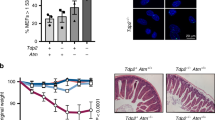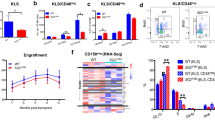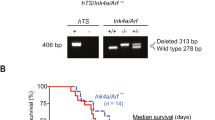Abstract
Ataxia-Telangiectasia (A-T) is an autosomal recessive human disease characterized by genetic instability, radiosensitivity, immunodeficiency and cancer predisposition, because of mutation in both alleles of the ATM (ataxia-telangiectasia mutated) gene. The role of Atm heterozygosity in cancer susceptibility is controversial, in both human and mouse. Earlier studies identified deletions near the Atm gene on mouse chromosome 9 in radiation-induced lymphomas from p53 heterozygous mice. To determine whether Atm was the target of these deletions, Atm heterozygous as well as Atm/P53 double heterozygous mice were treated with ionizing radiation. There were no significant differences in tumor latency, progression and lifespan after γ-radiation in Atm heterozygous mice compared with their wild-type control counterparts. Deletions were found on chromosome 9 near the Atm locus in radiation-induced tumors, but in 50% of the cases the deletion included the knockout allele, and the expression of Atm was maintained in the tumors indicating that loss of heterozygosity on chromosome 9 is not driven by Atm, but by an alternative tumor suppressor gene located near Atm on this chromosome. We conclude that Atm heterozygosity does not confer an increase in tumor susceptibility in this context.
This is a preview of subscription content, access via your institution
Access options
Subscribe to this journal
Receive 50 print issues and online access
$259.00 per year
only $5.18 per issue
Buy this article
- Purchase on Springer Link
- Instant access to full article PDF
Prices may be subject to local taxes which are calculated during checkout



Similar content being viewed by others
References
Athma P, Rappaport R, Swift M . (1996). Molecular genotyping shows that ataxia-telangiectasia heterozygotes are predisposed to breast cancer. Cancer Genet Cytogenet 92: 130–134.
Balmain A . (2002). Cancer as a complex genetic trait: tumor susceptibility in humans and mouse models. Cell 108: 145–152.
Barlow C, Eckhaus MA, Schäffer AA, Wynshaw-Boris A . (1999). Atm haploinsufficiency results in increased sensitivity to sublethal doses of ionizing radiation in mice. Nat Genet 21: 359–360.
Barlow C, Hirotsune S, Paylor R, Liyanage M, Eckhaus M, Collins F et al. (1996). Atm-deficient mice: a paradigm of ataxia telangiectasia. Cell 86: 159–171.
Bishop DT, Hopper J . (1997). AT-tributable risks? Nat Genet 15: 226.
Bowen TJ, Yakushiji H, Montagna C, Jain S, Ried T, Wynshaw-Boris A . (2005). Atm heterozygosity cooperates with loss of Brca1 to increase the severity of mammary gland cancer and reduce ductal branching. Cancer Res 65: 8736–8746.
Burns PA, Bremner R, Balmain A . (1991). Genetic changes during mouse skin tumorigenesis. Environ Health Perspect 93: 41–44.
Cai WW, Mao JH, Chow CW, Damani S, Balmain A, Bradley A . (2002). Genome-wide detection of chromosomal imbalances in tumors using BAC microarrays. Nat Biotechnol 20: 393–396.
Chen J, Birkholtz GG, Lindblom P, Rubio C, Lindblom A . (1998). The role of ataxia-telangiectasia heterozygotes in familial breast cancer. Cancer Res 58: 1376–1379.
Cho KR, Vogelstein B . (1992). Genetic alterations in the adenoma-carcinoma sequence. Cancer 70: 1727–1731.
Connolly L, Lasarev M, Jordan R, Schwartz JL, Turker MS . (2006). Atm haploinsufficiency does not affect ionizing radiation mutagenesis in solid mouse tissues. Radiat Res 166: 39–46.
Donehower LA, Harvey M, Slagle BL, McArthur MJ, Montgomery Jr CA, Butel JS, Bradley A . (1992). Mice deficient for p53 are developmentally normal but susceptible to spontaneous tumours. Nature 356: 215–221.
Elson A, Wang Y, Daugherty CJ, Morton CC, Zhou F, Campos-Torres J et al. (1996). Pleiotropic defects in ataxia-telangiectasia protein-deficient mice. Proc Natl Acad Sci USA 93: 13084–13089.
FitzGerald MG, Bean JM, Hegde SR, Unsal H, MacDonald DJ, Harkin DP et al. (1997). Heterozygous ATM mutations do not contribute to early onset of breast cancer. Nature Genet 15: 307–310.
Gatti RA, Tward A, Concannon P . (1999). Cancer risk in ATM heterozygotes: a model of phenotypic and mechanistic differences between missense and truncating mutations. Mol Genet Metab 68: 419–423.
Hansel DE, Kern SE, Hruban RH . (2003). Molecular pathogenesis of pancreatic cancer. Annu Rev Genomics Hum Genet 4: 237–256.
Inskip HM, Kinlen LJ, Taylor AM, Woods CG, Arlett CF . (1999). Risk of breast cancer and other cancers in heterozygotes for ataxia-telangiectasia. Br J Cancer 7: 1304–1307.
Jacks T, Remington L, Williams BO, Schmitt EM, Halachmi S, Bronson RT et al. (1994). Tumor spectrum analysis in p53-mutant mice. Curr Biol 4: 1–7.
Karabinis ME, Larson D, Barlow C, Wynshaw-Boris A, Moser AR . (2001). Heterozygosity for a mutation in Brca1 or Atm does not increase susceptibility to ENU-induced mammary tumors in ApcMin/+ mice. Carcinogenesis 22: 343–346.
Kemp CJ, Wheldon T, Balmain A . (1994). p53-deficient mice are extremely susceptible to radiation-induced tumorigenesis. Nat Genet 8: 66–69.
Lu S, Shen K, Wang Y, Santner SJ, Chen J, Brooks SC, Wang YA . (2006). Atm-haploinsufficiency enhances susceptibility to carcinogen-induced mammary tumors. Carcinogenesis 27: 848–855.
Mao JH, Perez-Losada J, Wu D, Delrosario R, Tsunematsu R, Nakayama KI et al. (2004). Fbxw7/Cdc4 is a p53-dependent, haploinsufficient tumour suppressor gene. Nature 432: 775–779.
Matsuoka S, Ballif BA, Smogorzewska A, McDonald III ER, Hurov KE, Luo J et al. (2007). ATM and ATR substrate analysis reveals extensive protein networks responsive to DNA damage. Science 316: 1160–1166.
Nakamura Y . (1998). ATM: the p53 booster. Nat Med 4: 1231–1232.
Olsen JH, Hahnemann JM, Børresen-Dale AL, Brøndum-Nielsen K, Hammarström L, Kleinerman R et al. (2001). Cancer in patients with ataxia-telangiectasia and in their relatives in the nordic countries. J Natl Cancer Inst 93: 121–127.
Shiloh Y . (2003). ATM and related protein kinases: safeguarding genome integrity. Nat Rev Cancer 3: 155–168.
Spring K, Ahangari F, Scott SP, Waring P, Purdie DM, Chen PC et al. (2002). Mice heterozygous for mutation in Atm, the gene involved in ataxia-telangiectasia, have heightened susceptibility to cancer. Nat Genet 32: 185–190.
Swift M, Morrell D, Massey RB, Chase CL . (1991). Incidence of cancer in 161 families affected by ataxia-telangiectasia. N Engl J Med 325: 1831–1836.
Taylor AM, Metcalfe JA, Thick J, Mak YF . (1996). Leukemia and lymphoma in ataxia telangiectasia. Blood 87: 423–438.
Teraoka SN, Malone KE, Doody DR, Suter NM, Ostrander EA, Daling JR et al. (2001). Increased frequency of ATM mutations in breast carcinoma patients with early onset disease and positive family history. Cancer 92: 479–487.
Umesako S, Fujisawa K, Iiga S, Mori N, Takahashi M, Hong DP et al. (2005). Atm heterozygous deficiency enhances development of mammary carcinomas in p53 heterozygous knockout mice. Breast Cancer Res 7: R164–R170.
Vorechovsky I, Rasio D, Luo L, Monaco C, Hammarstrom L, Webster AD et al. (1996). The ATM gene and susceptibility to breast cancer: analysis of 38 breast tumors reveals no evidence for mutation. Cancer Res 56: 2726–2732.
Westphal CH, Hoyes KP, Canman CE, Huang X, Kastan MB, Hendry JH et al. (1998). Loss of Atm radiosensitizes multiple p53 null tissues. Cancer Res 58: 5637–5639.
Westphal CH, Rowan S, Schmaltz C, Elson A, Fisher DE, Leder P . (1997). Atm and p53 cooperate in apoptosis and suppression of tumorigenesis, but not in resistance to acute radiation toxicity. Nat Genet 16: 397–401.
Wooster R, Ford D, Mangion J, Ponder BA, Peto J, Easton DF et al. (1993). Absence of linkage to the ataxia telangiectasia locus in familial breast cancer. Hum Genet 92: 91–94.
Worgul BV, Smilenov L, Brenner DJ, Junk A, Zhou W, Hall EJ . (2002). Atm heterozygous mice are more sensitive to radiation-induced cataracts than are their wild-type counterparts. Proc Natl Acad Sci USA 99: 9836–9839.
Xu Y, Ashley T, Brainerd EE, Bronson RT, Meyn MS, Baltimore D . (1996). Targeted disruption of ATM leads to growth retardation, chromosomal fragmentation during meiosis, immune defects, and thymic lymphoma. Genes Dev 10: 2411–2422.
Yu Y, Okayasu R, Weil MM, Silver A, McCarthy M, Zabriskie R et al. (2001). Elevated breast cancer risk in irradiated BALB/c mice associates with unique functional polymorphism of the Prkdc (DNA-dependent protein kinase catalytic subunit) gene. Cancer Res 61: 1820–1824.
Acknowledgements
We thank Dr Gonzalez-Sarmiento, Dr Sanchez-Garcia and Dr Cobaleda for useful comments; and Dr Kogan for tumor pathology analysis. Dr Balmain acknowledges support from the Barbara Bass Bakar Chair of Cancer Genetics. Dr Perez-Losada is an investigator of the ‘Programa Ramón y Cajal’ from the Spanish ‘Ministerio de Educación y Ciencia’ and the European Community, his study is partially supported by the ‘Fondo de Investigaciones Sanitarias’ (PI070057). Dr Castellanos is supported by the ‘Fondo de Investigaciones Sanitarias’ (PI070057). These studies were also supported by NCI grant U01 CA84244 and the DOE (DE-FG02-03ER63630) to Dr Balmain, and the UCSF Research-Evaluation Allocation Committee (REAC) to Dr Mao.
Author information
Authors and Affiliations
Corresponding authors
Additional information
Supplementary Information accompanies the paper on the Oncogene website (http://www.nature.com/onc)
Supplementary information
Rights and permissions
About this article
Cite this article
Mao, J., Wu, D., DelRosario, R. et al. Atm heterozygosity does not increase tumor susceptibility to ionizing radiation alone or in a p53 heterozygous background. Oncogene 27, 6596–6600 (2008). https://doi.org/10.1038/onc.2008.280
Received:
Revised:
Accepted:
Published:
Issue Date:
DOI: https://doi.org/10.1038/onc.2008.280
Keywords
This article is cited by
-
Inflammation, a significant player of Ataxia–Telangiectasia pathogenesis?
Inflammation Research (2018)
-
ATM mutations for surgeons
Familial Cancer (2017)
-
MEK inhibitors block growth of lung tumours with mutations in ataxia–telangiectasia mutated
Nature Communications (2016)



